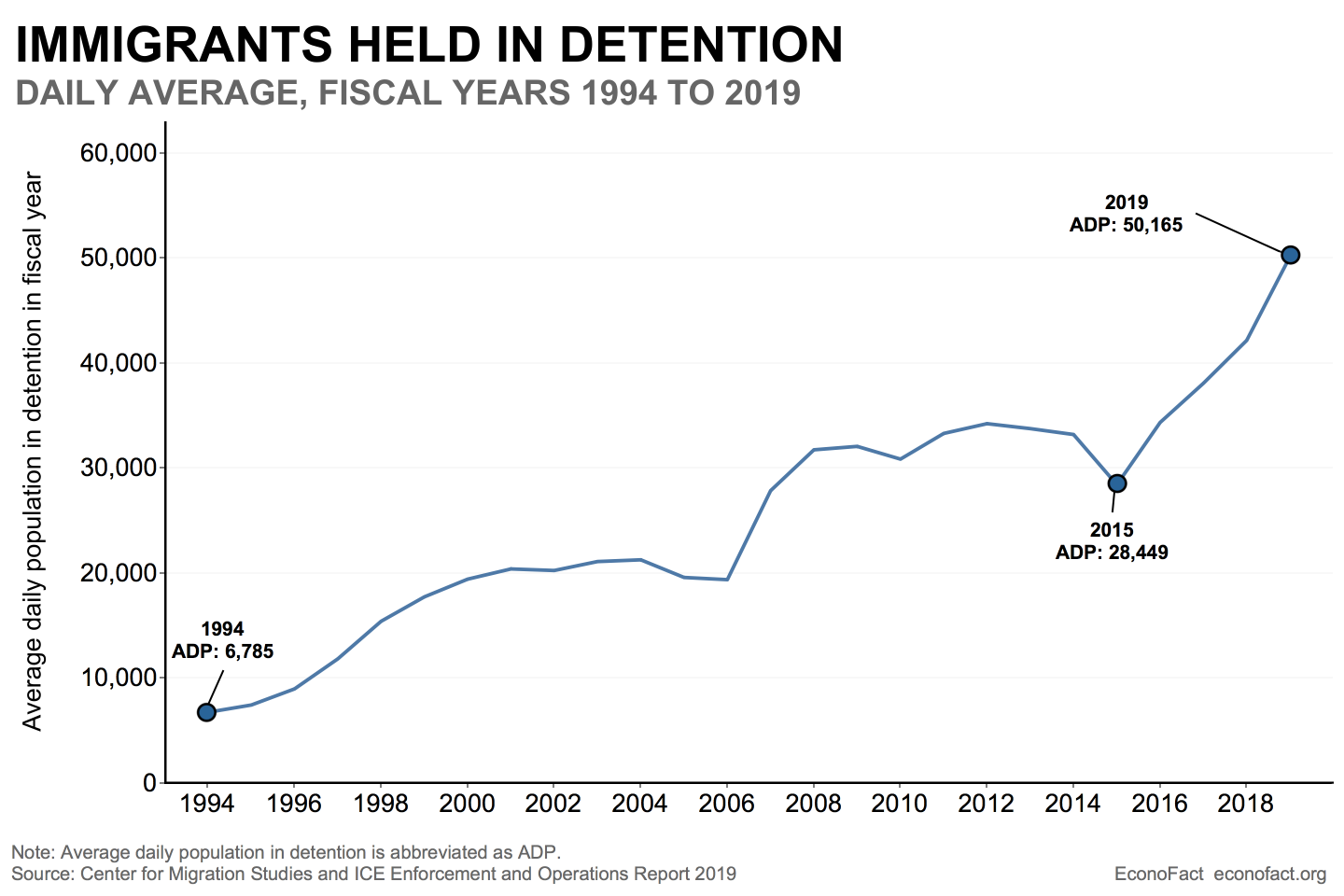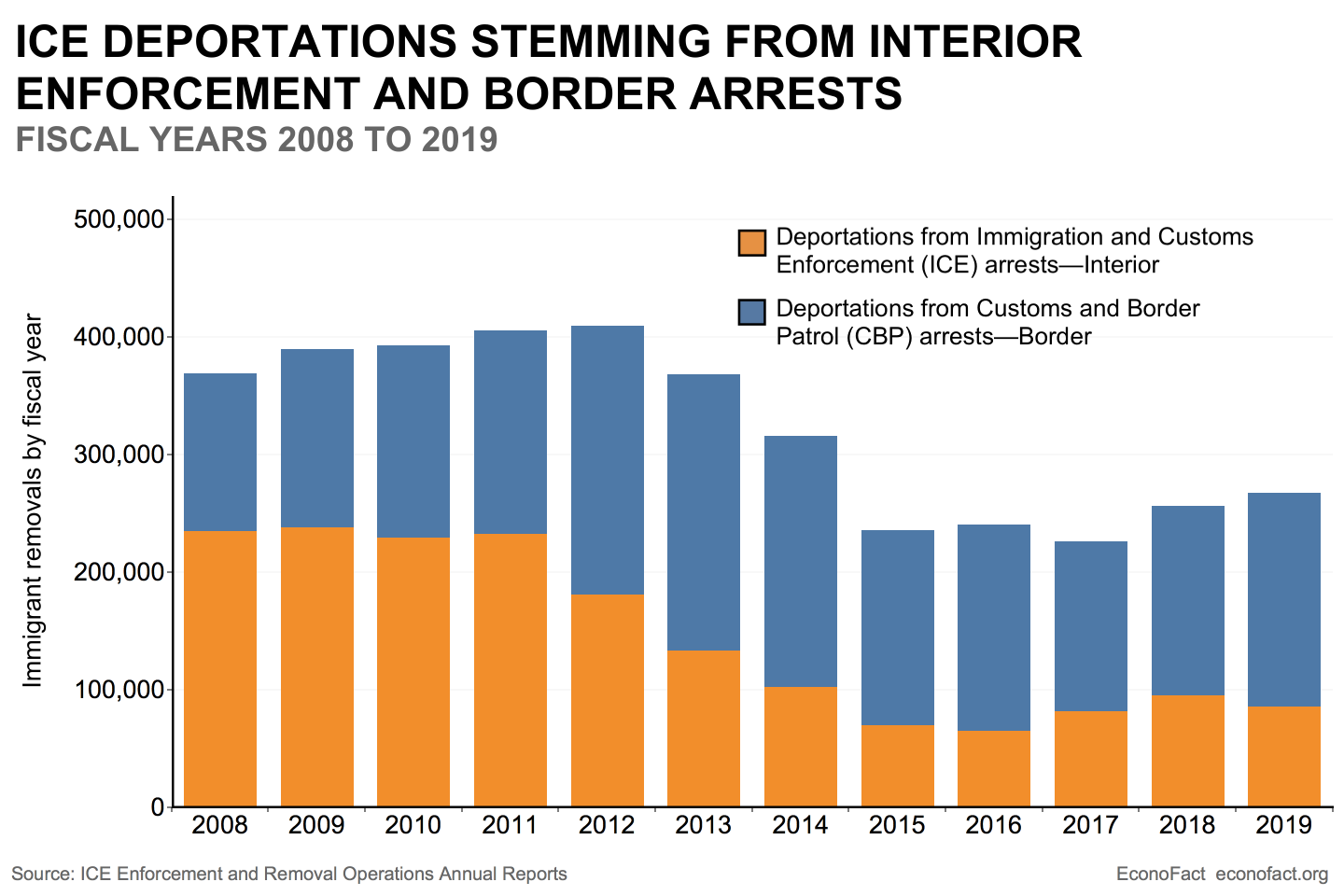Immigrant Deportations During the Trump Administration
Williams College
The Issue:
Increased immigration enforcement was a stated policy goal of the Trump administration. Over the course of four years, myriad policy changes ranging from less-noted technical adjustments to over 400 executive actions on immigration changed the way, among other things, of how interior enforcement was conducted. What was the effect on immigrants living in the United States without authorization? The statistics available to date suggest that interior arrests and deportations did ramp up, but fell far short of returning to the levels at the end of the George W. Bush administration and early Obama years. Though comparatively modest in its enforcement statistics, the Trump-era approach to immigration enforcement was characterized by less focus on immigrants with criminal histories and increased use of detention.
Relative to the late Bush and early Obama eras, the Trump administration removed a modest number of immigrants from the nation’s interior.
The Facts:
- Aggregate deportation statistics can be misleading because they include both actions against those living in the United States for many years and individuals turned back at the border. To get a clearer picture it is helpful to separate enforcement actions initiating with Customs and Border Patrol (CBP) — which typically refer to actions aimed at stemming entry — from those initiating with Immigration and Customs Enforcement (ICE), which are more likely to involve the population of roughly 11 million undocumented immigrants who live in the United States. Border enforcement statistics often have less to do with policy decisions and instead can reflect changes in migration flows. For example, in 2019, large numbers of Central American asylum seekers were taken into custody at the border, raising the overall arrest rate. Aggregate border numbers can also vary due to changes in reporting practices; the early Obama years increased the degree to which failed border crossing attempts were entered in the system as a formal removal. Consistent measurement of interior removals and apprehensions dates back to 2008. Because interior enforcement typically impacts those who live and work in the United States, it has distinct effects on local businesses, families, and communities, and should be considered independently from border enforcement.
- Interior removals (deportations) rose during the Trump administration relative to the immediately preceding years — but were lower than levels experienced during the years between 2008 and 2012. The number of interior deportations fell from over 200,000 annually in 2008-2011 to under 70,000 by the end of Obama’s presidency. Interior removals were higher in 2017-2019 (the latest number available), but never exceeded 100,000 (see chart). Given the long backlog in processing immigration cases, interior arrests give a better picture of the contemporary enforcement situation on the ground. Interior arrests follow a similar pattern of rising under Trump but failing to rebound to early Obama levels.
- There was an increase in arrests made in the community (as opposed to a jail setting), and more of the individuals arrested had no criminal history. The Trump administration publicly eschewed priorities for enforcement actions — the numbers in the category of ‘community arrests of non-criminals’ rose from 3,970 in FY 2016 to 10,245 in FY 2019. It is important to note that this category of arrests did not dominate ICE activity, with a majority of apprehensions taking place in jails through the Secure Communities program (a policy initially piloted in 2008 that increased cooperation between local law enforcement and immigration officials and resulted in an increase in deportations of individuals who came into contact with local authorities). However, community arrests are high-visibility events that raised the perceived risk and fear among many undocumented immigrants living in the United States.
- The use of detention was one area of immigration enforcement that expanded dramatically and reached record highs during the Trump administration. The average number of individuals in immigration detention each day was 28,000 in 2015 and 50,000 in 2019, far exceeding historical patterns (see chart below). These figures include those living in the United States awaiting an immigration hearing as well as asylum seekers awaiting a decision. Though most of the 1.2 million unauthorized residents waiting for a hearing are not in detention, the Trump administration favored increasing the use of detention as a complement to alternatives like ankle monitors.

- Enforcement activity can generate “chilling effects” that affect the daily lives of immigrants and their families. The fear generated by increased enforcement can have broader effects that go beyond increasing detentions and deportations. An estimated 5 million children live with an unauthorized parent, including 4 million citizen children, and research suggests these children are less likely to access needed services and programs when the perceived risk is elevated.
What this Means:
While many people may assume that annual deportation figures refer to the removal of unauthorized immigrants living and working in the United States, in reality these numbers combine interior deportations with actions at the border — such as when asylum seekers turn themselves in to authorities or individuals are captured while attempting to cross the border without authorization. It is important to break down deportation statistics in order to get a clearer understanding of immigration enforcement inside the country. Relative to the late Bush and early Obama eras, the Trump administration removed a modest number of immigrants from the nation’s interior. Instead, the administration increased the visibility and unpredictability of enforcement activity directed at unauthorized individuals living within the U.S. and expanded the use of detention as part of immigration enforcement.
Like what you’re reading? Subscribe to EconoFact Premium for exclusive additional content, and invitations to Q&A’s with leading economists.

